【转自high peaks pure earth/高峰净土网站。感谢译者Elliot Sperling(艾略特·史伯岭)先生。感谢高峰净土网站】
“Our Lhasa is on the Verge of Destruction! Please, Save Lhasa!” By Woeser
High Peaks Pure Earth is very grateful to Elliot Sperling for his translation of a blogpost by Woeser originally written for the Mandarin service of Radio Free Asia on May 4, revised on May 6 and posted on her blog on May 7, 2013.
The blogpost is an appeal to save Lhasa from destructive modernisation and has already attracted media attention. It was reported by Associated Press in Beijing in December 2012 that Lhasa’s government had started a seven-month, 1.2 billion RMB project to “help preserve Lhasa’s ancient heart”. As a place that Woeser considers to be her home, Lhasa is often written about in both poetry and prose. Previously,Woeser has expressed her concern about the pace of changes taking place in Lhasa today.
Please note that nowhere in the blogpost is the claim made that Tibet’s holiest temple, the Jokhang, is being demolished.
Please scroll to the bottom of the post to see 20 more photos.
The space in front of the Jokhang, which has borne witness to so much change over the ages, has no more of the pilgrims from Kham and Amdo who prostrate themselves all the way from the far borders to Lhasa; no more lamp pavilions in which thousands and tens of thousands of butter lamp offerings were lit every day. Only snipers poised on the roofs of Tibetans’ homes, and fully armed military sweeps; only the opening of one massive government-business sector joint venture shopping mall after another, each with inflatable blood-red plastic columns before their doors, flaunting the vulgarity and invasiveness of these new upstart operations.
“Our Lhasa is on the Verge of Destruction! Please, Save Lhasa!”
By Woeser
Our Lhasa is on the verge of destruction; this is absolutely not a case of crying wolf!
A tourist who’s been to Lhasa wrote on Sina Weibo: “Today I can understand clearly that the original intended objective for Lhasa has been the construction of an extravagant tourist-city monstrosity along the lines of Lijiang. All the Old City’s street stalls, guest houses, and its low-end service sector have to move out, to be replaced by high-end art and antique shops, and hotels. Moreover, all the buildings along the old streets have to have uniform facades and uniform signboards. So is it that China’s cities are to have only this one type of dumbass Korean-style beauty makeover?”
Note that among the photographs that this tourist posted, the “Construction Survey” for the Barkhor Shopping Mall (originally the site of the Chengguan District Government Headquarters; located in the northeast section of the Barkhor, the circumambulation route around the Jokhang, and located very close to what is generally called Barkhor Street, also within the Old City of Lhasa) presents the scope of the project as encompassing 150,000 square meters, with an underground parking garage alone containing 1,117 parking spaces. Moreover, last year, because the colossal “Spiritual Power Plaza,” a government-business sector joint venture built at the edge of the Old City of Lhasa, which had yet to open, was constructing an underground parking garage, it was pumping out groundwater day and night for over two years, causing anxiety among Lhasa residents as well as worries about cracks ripping through the Old City of Lhasa and depressions that could reach the dangerous point of forming sinkholes. Actually, cracks have already appeared in many places, while excavated sites have no water. And now the authorities want to construct a huge shopping center with an underground parking garage in another part of the Old City. Does this mean that we’ve reached a point at which it is now nigh impossible to prevent Lhasa from falling into the destructive clutches of hungry ghosts?
Remember: in 1994, UNESCO placed the Potala Palace on the World Heritage List. But then, in 1996, the village of Shol, which had stood for 1100 years at the foot of the Potala Palace was moved and relocated. At the same time, the Potala Palace, now deprived of Shol, was fatally disfigured with a public square: a replica of all those identical squares found throughout China, that are meant to display and project supreme power and authority. In 2000 and 2001 UNESCO listed the Jokhang and the Norbulingka on the World Heritage List as extensions of the Potala, making Lhasa, already a sacred place in terms of its value for religion, history and the humanities, a part of the world’s cultural heritage. Nominally then, it ought to receive protection simply as a matter of course. But in 2002 Tibetans received a deep wound to their hearts: an artillery shell-shaped “Monument to the Peaceful Liberation of Tibet” was put up to tower easily over the square, facing off against the Potala Palace in the distance. In 2007 the Potala Palace received a “Yellow Card Warning” at the World Heritage Conference, with criticism leveled for the excessive and gross pursuit of tourism profits, for unrestrained exploitation and for failing to uphold its responsibilities and commitments. The Potala Palace was put at risk of losing its “World Heritage” designation.
What is regrettable is that now, not only does the Potala continue to be subjected every year to excessive exploitation for purposes of tourism, but, under the feet of several million tourists whose numbers continually increase, even Lhasa’s Old City is precariously and dangerously changing its appearance as it follows the trajectory of becoming an “International Tourist City.” Not only have its guts been opened, things have become drastic. It’s just as the Tibetan artist Kuang Laowu judged: “Faced with the lure of material goods and the seductions of power, cultural distinctiveness loses out and urban uniformity is imposed. Behind this seeming burst of prosperity the Old City of Lhasa, its substance, long since depleted, is yesterday’s faded lily; none of its ancient simplicity, with the traces of ages past, is to be found there.”
Years ago, between 1996 and 2002, Andre Alexander, a German who had devoted himself to restoring the Old City of Lhasa, in concert with the Tibet Heritage Foundation which he founded, rescued 76 traditional structures in and around Lhasa and revealed the true state of affairs, stating that “starting in 1980 the construction process within the city has wrought unceasing destruction on the Old City’s ancient structures and quarters.” “From 1993 on, each year an average of 35 historic structures have been demolished. At this rate the remaining historic structures will have vanished in less than 4 years.” Because their remarkable restoration work and the witness they bore went totally against the intentions of the powers that be, in the end they were expelled from Lhasa by the authorities in Tibet—authorities who single-mindedly pursue only what is in their own interests.
From the “Engineering Survey” for the “Barkhor Shopping Mall” we can see that the goal of the renovation of the Barkhor quarter is to “cleanse, disperse, transform and elevate.” And the reality that is to be understood by this is that the reconstruction of the Old City is to be divided into several large parts: the heart of the Old City, the circumambulation path around the Jokhang is to be thoroughly cleared. All the street peddlers are to be moved inside the newly-built “Barkhor Shopping Mall.” All of the residents originally living along the street are to be moved to Tolung Dechen County in the western suburb of Lhasa; those households that move quickly can get a subsidy of between 20,000 and 30,000 RMB. Not moving will be a political problem. It’s said that one old person in Lhasa who was unwilling to move has gone completely mad. As for the empty homes and courtyards, they’ll be used to draw investment bids. Stores, restaurants, bars, art galleries and the like are to be established here. And on other streets and allies in the Old City, such as the space in front of the Ramoche temple, big public squares are to be opened up. The surrounding households will similarly be moved to the suburbs. In the northeast corner of the Old City, the site of the former Chengguan District Government Headquarters, the Barkhor Shopping Mall has already been erected. And so it goes, on and on…
Of course, the Barkhor, which was originally a place of religious significance, won’t turn into a deserted street. On the contrary, it will become a bustling street, existing only for the benefit of tourists. But it will never again be the street of those Tibetans who circumambulate, come on pilgrimage, and prostrate themselves. Even if there manage to be pilgrims making prostrations there, they will simply serve to liven things up as background for the tourists, as one disaster follows another, winding down to a pathetic and miserable end for Lhasa. Historically, Lhasa has never had a mining cave-in. And now, it has had a mining cave-in. Historically, the Kyichu has never been blocked and dried up. Now it is drying up to the point that the fish are all dying. Historically, the Old City of Lhasa has never existed solely as a backdrop for tourists. And now it’s being changed into a replica of Sifang Street in Lijiang and Daka Dzong in “Shangri-La.” Might it be that one day, perhaps very soon, entry into the mountain fortress version of these tourist traps, “Old City Lhasa,” will require the purchase of tickets?
No place has disappeared so quickly; no place has been inundated so quickly. Sick at heart, Andre Alexander wrote; “Each time I go, the old houses are clearly fewer, stone by stone, brick by brick, alley by alley, street by street; even the dogs are going missing.” And today it’s being relaced by a new Lhasa City that is being commercialized by those in power. From here on in, it’s not just me, one individual, it’s many people who are losing the few remaining bits of the Lhasa cityscape that they so deeply love; from here on in, it’s not just my life, one individual life, it’s the lives of many people, all mixed together with memories of Lhasa, that are being covered over. It’s just as one internet friend bitterly put it: “Dismantling the old structures, excavating tunnels, building crossover bridges, stopping up the Kyichu, draining the groundwater: these people are truly the incarnations of hungry ghosts! Whatever they can carry away, they carry away, and what they can’t carry away they destroy!”
I should point out that over the last several years the self-immolations of 121 Tibetans have become the most conspicuous manifestation of the Tibet Issue. It matters little that the international community is only paying limited attention to it, it is still the focus of the Tibetan Government-in-Exile; everything is concentrated around it and other catastrophes and dangers faced by Tibetan society are getting scant notice. For example, right now the looming destruction of Lhasa’s Old City is staring us in the face. If this were taking place in the past, UNESCO could still issue a “Yellow Card Warning.” However, now no one is paying attention, no one is concerned.
But the Chinese Government is taking the Tibetan self-immolations very seriously. On May 27 last year two Tibetans committed self-immolation in the space between the Jokhang and the Barkhor police substation. The Barkhor police substation was immediately elevated to the level of “Barkhor Ancient City Public Security Bureau.” The Mandala Hotel in which the two Tibetan self-immolators had taken lodgings was seized by the authorities and turned into the “Lhasa Barkhor Ancient City Management Committee.” The Old City of Lhasa was renamed the “Barkhor Ancient City.” But the large-scale rebuilding of the Old City by the authorities that resulted from this was actually a case of killing two birds with one stone; it was even more suited to the goals and plans for “maintaining stability.” And now, the area in front of the Jokhang, which has borne witness to so much change over the ages, has no more of the pilgrims from Kham and Amdo who prostrate themselves all the way from the far borders to Lhasa; no more lamp pavilions in which thousands and tens of thousands of butter lamp offerings were lit every day. Only snipers poised on the roofs of Tibetans’ homes, and fully armed soldiers on patrol; only the opening of one massive government-business sector joint venture shopping mall after another, each with inflatable blood-red plastic columns before their doors, flaunting the vulgarity and invasiveness of these new upstart operations.
Forty years ago, when UNESCO adopted the Convention Concerning the Protection of the World Cultural and Natural Heritage, it recognized “the importance, for all the peoples of the world, of safeguarding this unique and irreplaceable property, to whatever people it may belong…” noting that the “deterioration or disappearance of any item of the cultural or natural heritage constitutes a harmful impoverishment of the heritage of all the nations of the world”… and asserting that “it is incumbent on the international community as a whole to participate in the protection of the cultural and natural heritage…”
For these reasons I call on UNESCO and its affiliated organizations world-wide to stop this sort of frightful “modernization,” which constitutes an unpardonable and incalcuable crime against the ancient city of Lhasa’s landscape, human culture, and environment.
I call on the many Tibetologists all around the world, the people and organizations studying and researching the Tibet Issue: please pay close attention to the unredeemable misfortune that is befalling the Old City of Lhasa right at this very moment.
I hope people from all walks of life will launch actions to save the Old City of Lhasa!
Our Lhasa is on the Verge of Destruction!
Please, Save Lhasa!
Originally Written: May 4, 2013
Revised: May 6, 2013
Revised: May 6, 2013
The photographs below, showing the state of affairs in the Old City of Lhasa have been taken by tourists travelling to Lhasa as well as Tibetans in Lhasa:
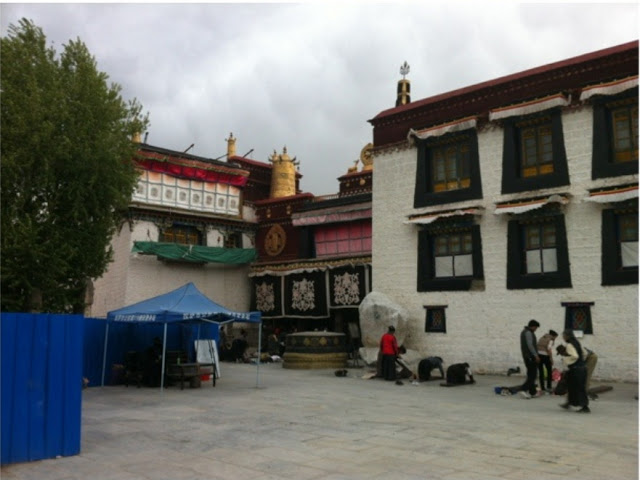
The space in front of the Jokhang, which has borne witness to so much change over the ages, has no more of the pilgrims from Kham and Amdo who prostrate themselves all the way from the far borders to Lhasa. Because they don’t have “Tibetan Entry Permits” they’re stopped at checkpoints along the pilgrimage route.
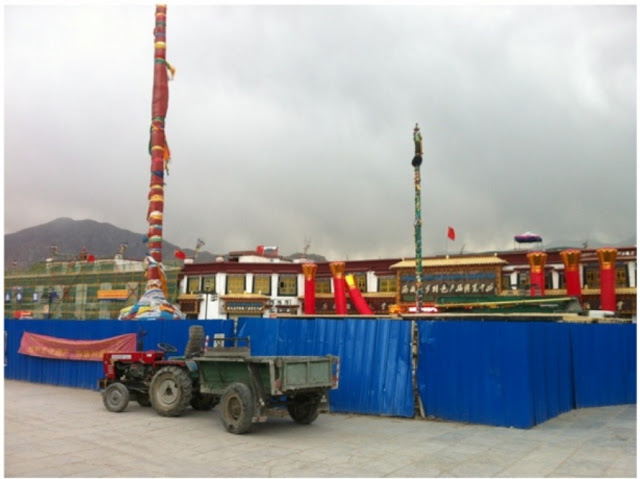
A Chinese resident of Lhasa wrote on the internet: “…Waking up one morning I took a look at this odd street. I had no idea that this was a major change. Previously, when I would relax I’d often sit atop Buchung’s stall, talking and laughing. This was my habit for over ten years. This sort of change meant for us a change in vision, or aesthetics, or lifestyle. But for Buchung it meant a change in the environment and conditions of his very subsistence. The matter truly touched those who livelihoods are in Tibet.
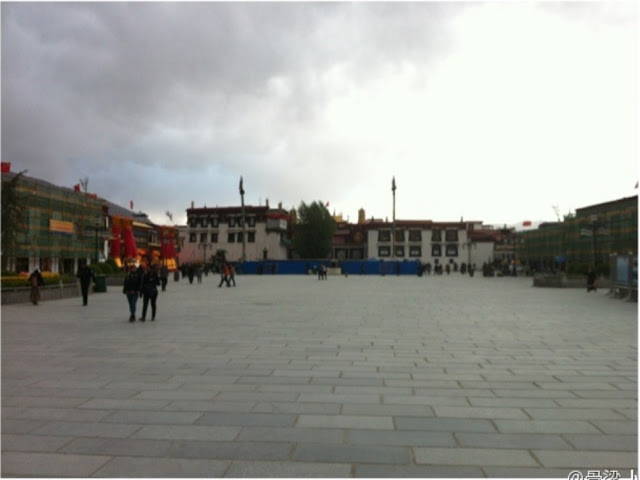
On the left a massive government-business sector joint venture shopping center has just opened, with particularly offensive inflatable blood-red plastic columns in front of the shopping center’s doors. One internet friend wrote “Taking a good look, it really lacks the least sense of beauty… simply nauseating… It’s as fucked-up as opening day at some county seat restaurant; nothing to say.”
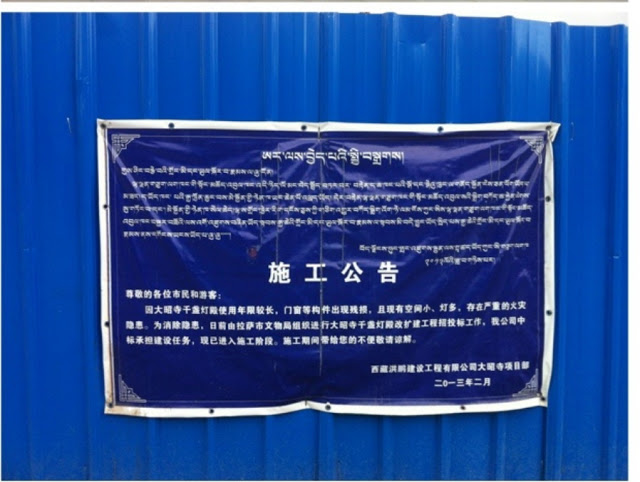
What was originally a pavilion of a thousand lamps in front of the Jokhang has been demolished for reconstruction, but it isn’t known what the further plan is.
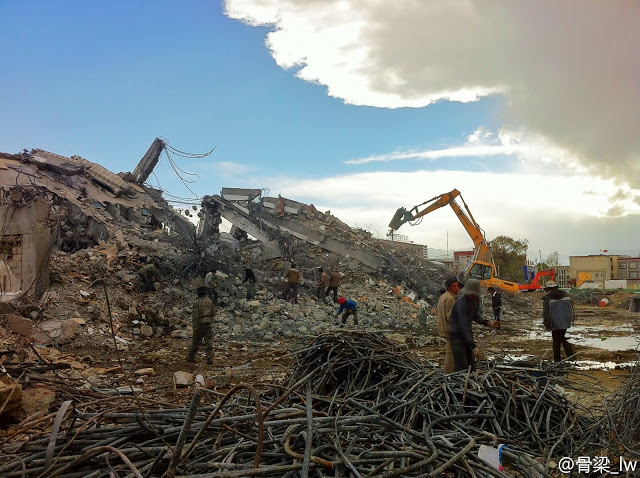
An internet friend says: “In front of the Dungtsho hostel, a big gash has been cut open to construct the Barkhor Shopping Mall. It’s said that the stalls on Barkhor Street that formerly sold Tibetan jewelry are subsequently to be collected together and moved here. Capitalist politics homogenizes everything.”
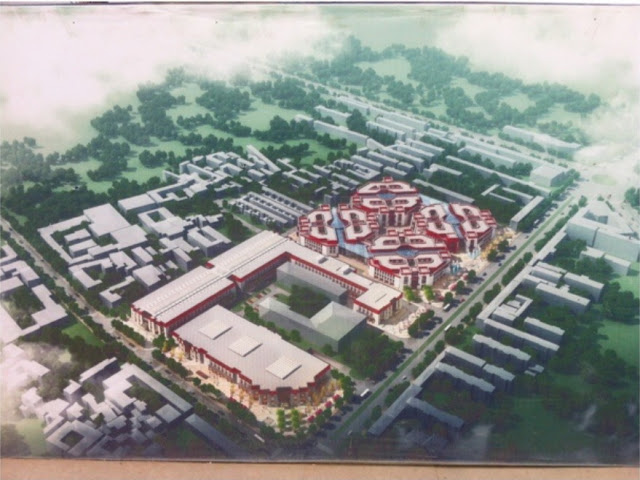
A display image of the Barkhor Shopping Mall, currently under construction. It is situated on what was originally the site of the Chengguan District government, located in the northeast section of the Barkhor, the circumambulation route around the Jokhang , very close to what is commonly called Barkhor Street, also within the Old City of Lhasa.
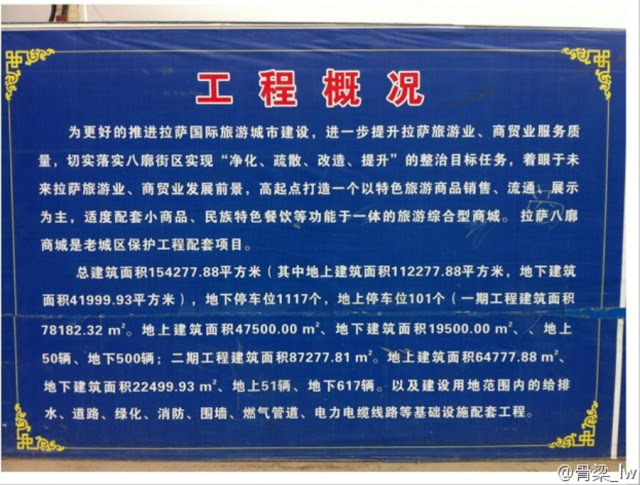
The “Construction Survey” for the soon-to-be-built Barkhor Shopping Mall presents the scope of the project as encompassing 150,000 square meters, with an underground parking garage alone containing 1,117 parking spaces.
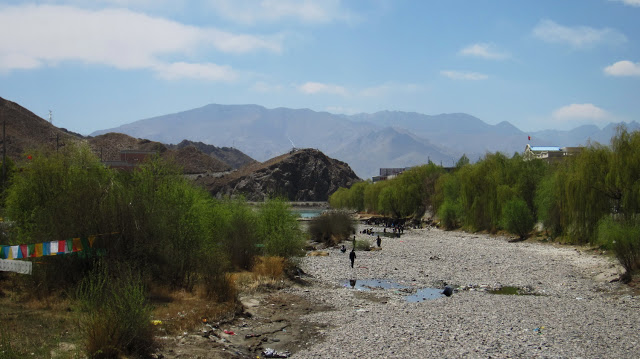
Not too long ago the Kyichu was blocked and it is running dry. Because the colossal “Spiritual Power Plaza,” a government-business sector joint venture is being built at the edge of the Old City of Lhasa, it has been pumping out groundwater day and night, causing anxiety among Lhasa residents I wrote to Andre Alexander, who had done restoration in Lhasa, for advice as to whether proceeding in this way could wreak damage. He wrote sorrowfully in reply: “Water in Tibet is a big problem because hydroelectric stations are being built all over the place. And in Lhasa itself, the environment has already been seriously damaged and polluted. Rapacious commercial development supported by rapacious government officials is turning the Kyichu Valley into one big factory. If the Lhalu wetlands go dry then it’s too late for anything.
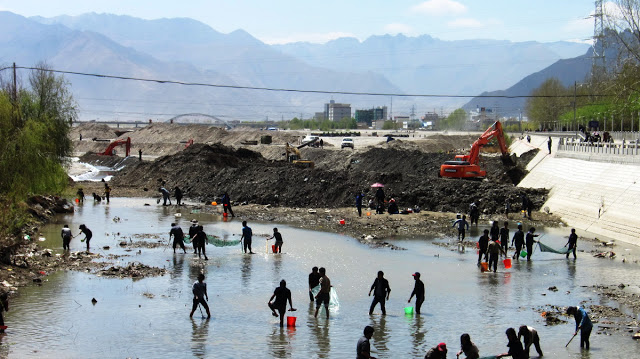
Not too long ago the Kyichu was blocked and its waters are running dry. A lot of Tibetans are spontaneously going out to save fish in the little that’s left of the water. This is really a terribly distressing and symbolic scene.

Mentsikhang Road in the Old City of Lhasa is also being dug up. During the time of the “Destroy the Four Olds” campaign of the Cultural Revolution, innumerable Buddhist images looted from temples and monasteries were buried on this street to make a show of trampling on the “Four Olds.” I don’t know whether or not any of these Buddhist images have been unearthed at present, while the city’s guts are being cut open.
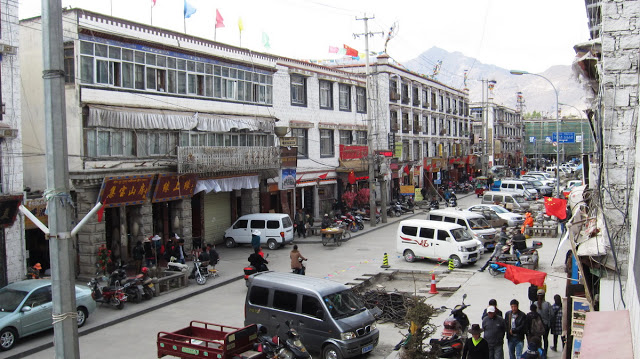
Mentsikhang Road in the Old City of Lhasa is also being dug up. During the time of the “Destroy the Four Olds” campaign of the Cultural Revolution innumerable Buddhist images looted from temples and monasteries were buried on this street to make a show of trampling on the “Four Olds.” I don’t know whether or not any of these Buddhist images have been unearthed at present, while the city’s guts are being cut open.
本文由自动聚合程序取自网络,内容和观点不代表数字时代立场






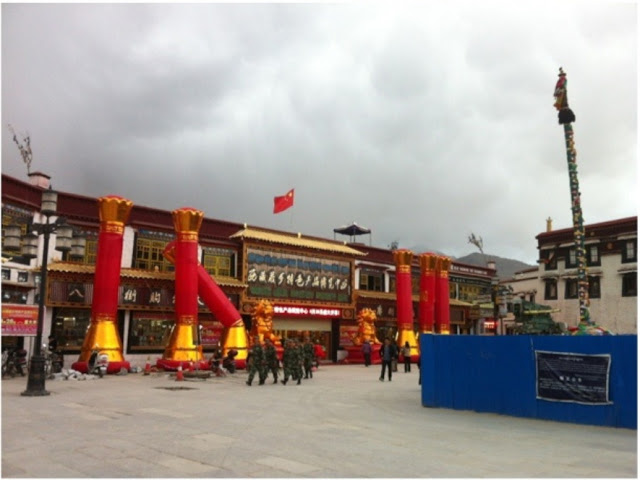
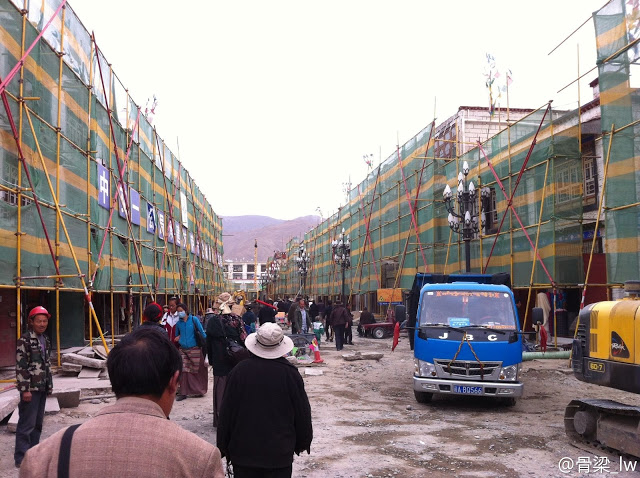
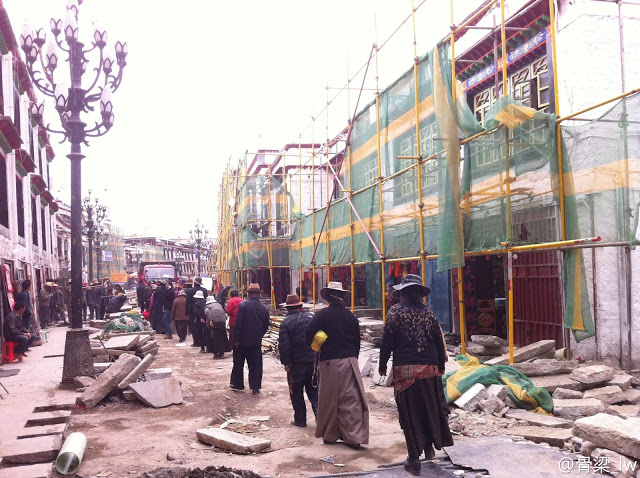
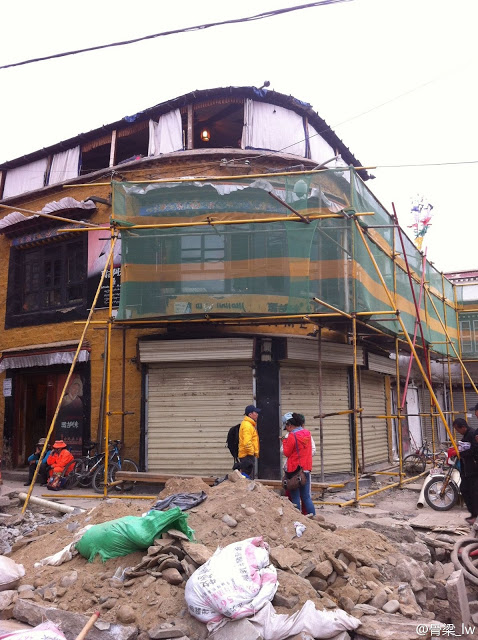
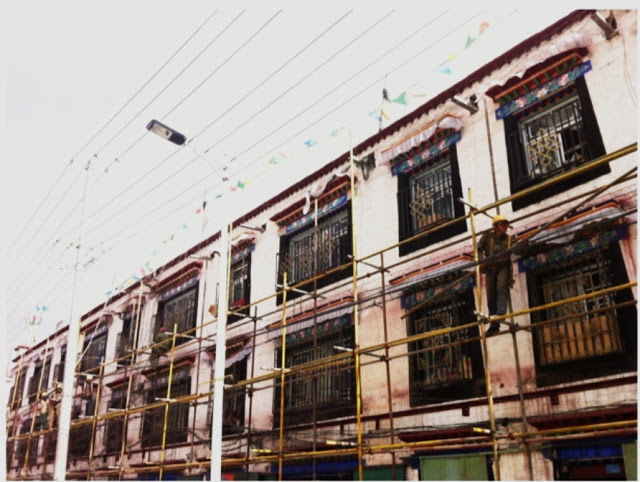
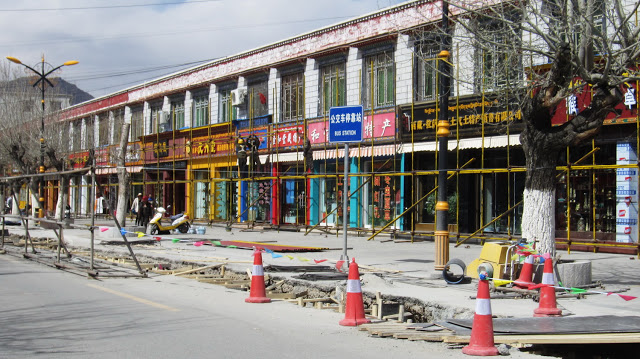
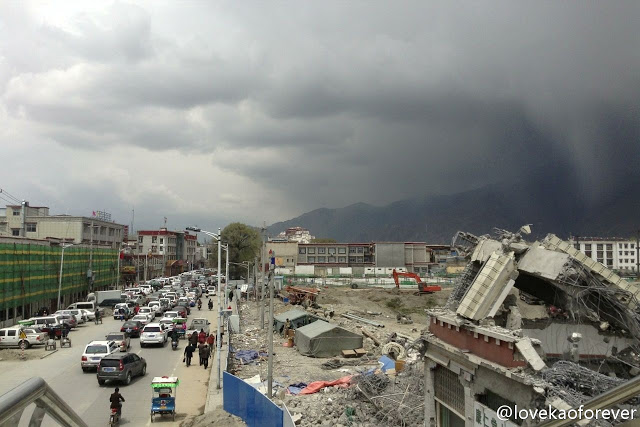

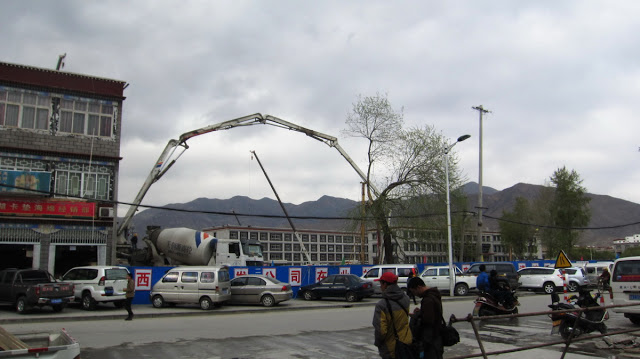
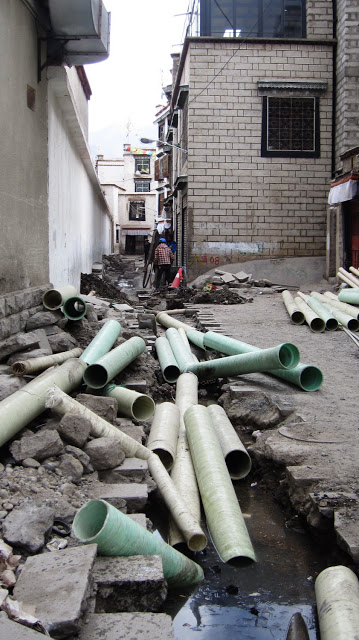

.png)

